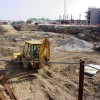Soil Stabilization
Video
alt="" Soil StabilizationSoil stabilization is the improvement of site soil characteristics to better facilitate a specific construction activity. Soil stabilization can be a mechanical technique using construction equipment, or a chemical application to change the soil’s inherent properties. Examples of mechanical soil stabilization include compaction and placement of (geo-textile) filter fabrics. Chemical examples include treating soils with cement, lime, or asphalt to better stabilize them in order to receive applied loads. Grouting is another technique often used to stabilize soils.
Compaction is the controlled removal of air voids within a soil, increasing its density and ability to carry loads. Greater interlocking and friction between the soil particles occurs as the air voids are eliminated during compaction. Appropriate soil moisture content of the soil is an important consideration for proper compaction. Compaction is usually achieved with modern construction equipment designed for this purpose, including steel rollers, pneumatic-tired rollers, and sheep’s foot rollers. Years of industry experience have resulted in generally accepted guidelines for which types of soils and site gradients require which types (and weights) of rollers to achieve the desired compaction targets. Vibratory compactors are an alternative to compaction rollers. Compaction goals can be verified as necessary with field tests and/or soil samples.
Geo-textiles (filter fabrics) can be used a soil stabilization technique. The filter fabrics can be installed between layers of dissimilar soils (such as in pavement construction). The filter fabrics restrain fine soil particles from migrating from a parent soil, where they are necessary to maintain soil strength.
Chemical soil treatments include the addition of asphalt or Portland cement, lime, fly-ash, lignins, and calcium chloride. Asphalt or cement application is a common treatment for soil base materials placed beneath pavements. Specifically, granular base materials having a significant percentage of larger particles (gravel, crushed stone) without enough natural binders such as smaller (clay, silt) soil particles, are often cement treated and compacted. This technique provides a stronger soil matrix without a tighter blend of more well-graded natural soils. Other chemical treatments include hydrated lime, which in small amounts can greatly enhance the strength qualities of moist clays without a decrease in their moisture content. Fly-ash, a residue from industrial coal burning, is a pozzolan (a cement forming agent that reacts with lime) and is often used in conjunction with hydrated lime as a soil stabilizer similar to cement additives. Calcium chloride and lignins (by-products from paper manufacturing) can be sprayed on roadways constructed of compacted granular soils. These agents keep the fine soil particles in place, reducing dusting and maintenance.
Grouting methods involve injecting the soils in-place with liquid hardening agents.Grouting has the advantage of not disturbing the existing soils and is a practical method to stabilize deeper site soils. Grout pipes are placed into the soil at the desired elevation and the grout is discharged from the end of the pipes into the soil matrix. There are different grout pipe designs and techniques for varied site conditions. Grouting techniques that fill soil void spaces with liquid hardening agents are referred to as consolidation grouting. Grouting techniques that displace and thus compact existing soils with a volume of dense grout are called compaction grouting. During the grouting process, grout flow rates and pressures are monitored to ensure that proper grout volumes are installed for the known soil conditions and desired end state.

Buildipedia Staff
The Buildipedia research and writing staff consists of dozens of experienced professionals from many sectors of the industry, including architects, designers, contractors, and engineers.
Website: buildipedia.com/


